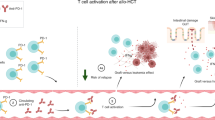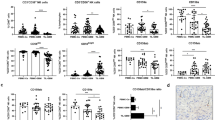Abstract
Killer lymphocytes play a central therapeutic role in graft-versus-leukemia following allogeneic hematopoietic stem cell transplantation (HSCT). The Perforin/Granzyme and FAS/CD95 pathways are of crucial importance in tumor cell elimination by killer cells. In this study, we have examined whether hematological malignancies are resistant to perforin and anti-FAS antibodies. Leukemic cells were studied from 29 patients suffering either from acute or chronic myeloid leukemia (AML or CML), acute or chronic lymphoid leukemia, or non-Hodgkin's lymphoma. An average of 49 vs 5% of specific cell killing was found when using perforin vs anti-FAS antibodies, respectively. Interestingly, resistance towards both perforin and anti-FAS antibodies was found exclusively in leukemic cells from patients with myeloid leukemia. Analysis of leukemic cells from patients with CML, suffering from leukemia relapse after HSCT and given donor lymphocyte infusion (DLI) to induce remission, indicated that the effectiveness of treatment with DLI was not associated with sensitivity of leukemic cells to perforin. In conclusion, resistance towards anti-FAS antibodies is a common phenomenon in leukemia/lymphoma, whereas perforin resistance occurs only in myeloid leukemia. However, as a single parameter, perforin resistance does not appear to be suitable to predict the outcome of DLI.
This is a preview of subscription content, access via your institution
Access options
Subscribe to this journal
Receive 12 print issues and online access
$259.00 per year
only $21.58 per issue
Buy this article
- Purchase on Springer Link
- Instant access to full article PDF
Prices may be subject to local taxes which are calculated during checkout





Similar content being viewed by others
References
Bortin MM, Horowitz MM, Rimm AA . Increasing utilization of allogeneic bone marrow transplantation. Results of the 1988–1990 survey. Ann Intern Med 1992; 116: 505–512.
Kolb HJ, Schattenberg A, Goldman JM, Hertenstein B, Jacobsen N, Arcese W et al. Graft versus-leukemia effect of donor lymphocyte transfusions in marrow grafted patients. Blood 1995; 86: 2041–2050.
Raiola AM, Van Lint MT, Valbonesi M, Lamparelli T, Gualandi F, Occhini D et al. Factors predicting response and graft-versus-host disease after donor lymphocyte infusions: a study on 593 infusions. Bone Marrow Transplant 2003; 31: 687–693.
Lokhorst HM, Schattenberg A, Cornelissen JJ, van Oers MH, Fibbe W, Russell I et al. Donor lymphocyte infusions for relapsed multiple myeloma after allogeneic stem-cell transplantation: predictive factors for response and long-term outcome. J Clin Oncol 2000; 18: 3031–3037.
Marks DI, Lush R, Cavenagh J, Milligan DW, Schey S, Parker A et al. The toxicity and efficacy of donor lymphocyte infusions given after reduced-intensity conditioning allogeneic stem cell transplantation. Blood 2002; 100: 3108–3114.
Trapani JA, Smyth MJ . Functional significance of the perforin/granzyme cell death pathway. Nat Rev Immunol 2002; 2: 735–747.
Barry M, Bleackley RC . Cytotoxic T lymphocytes: all roads lead to death. Nat Rev Immunol 2002; 2: 401–409.
Wulfing C, Purtic B, Klem J, Schatzle JD . Stepwise cytoskeletal polarization as a series of checkpoints in innate but not adaptive cytolytic killing. Proc Natl Acad Sci USA 2003; 100: 7767–7772.
Isaaz S, Baetz K, Olsen K, Podack E, Griffiths GM . Serial killing by cytotoxic T lymphocytes: T cell receptor triggers degranulation, re-filling of the lytic granules and secretion of lytic proteins via a non-granule pathway. Eur J Immunol 1995; 25: 1071–1079.
Stinchcombe JC, Bossi G, Booth S, Griffiths GM . The immunological synapse of CTL contains a secretory domain and membrane bridges. Immunity 2001; 15: 751–761.
Smyth MJ, Street SE, Trapani JA . Granzymes A and B are not essential for perforin-mediated tumor rejection. J Immunol 2003; 171: 515–518.
Smyth MJ, Thia KY, Street SE, MacGregor D, Godfrey DI, Trapani JA . Perforin-mediated cytotoxicity is critical for surveillance of spontaneous lymphoma. J Exp Med 2000; 192: 755–760.
Goping IS, Barry M, Liston P, Sawchuk T, Constantinescu G, Michalak KM et al. Granzyme B-induced apoptosis requires both direct caspase activation and relief of caspase inhibition. Immunity 2003; 18: 355–365.
Kagi D, Ledermann B, Burki K, Seiler P, Odermatt B, Olsen KJ et al. Cytotoxicity mediated by T cells and natural killer cells is greatly impaired in perforin-deficient mice. Nature 1994; 369: 31–37.
van den Broek ME, Kagi D, Ossendorp F, Toes R, Vamvakas S, Lutz WK et al. Decreased tumor surveillance in perforin-deficient mice. J Exp Med 1996; 184: 1781–1790.
Smyth MJ, Street SE, Trapani JA . Granzymes A and B are not essential for perforin-mediated tumor rejection. J Immunol 2003; 171: 515–518.
Lehmann C, Zeis M, Schmitz N, Uharek L . Impaired binding of perforin on the surface of tumor cells is a cause of target cell resistance against cytotoxic effector cells. Blood 2000; 96: 594–600.
Garcia-Lora A, Algarra I, Garrido F . MHC class I antigens, immune surveillance, and tumor immune escape. J Cell Physiol 2003; 195: 346–355.
Khong HT, Restifo NP . Natural selection of tumor variants in the generation of ‘tumor escape’ phenotypes. Nat Immunol 2002; 3: 999–1005.
Griffith TS, Brunner T, Fletcher SM, Green DR, Ferguson TA . Fas ligand-induced apoptosis as a mechanism of immune privilege. Science 1995; 270: 1189–1192.
Snell V, Clodi K, Zhao S, Goodwin R, Thomas EK, Morris SW et al. Activity of TNF-related apoptosis-inducing ligand (TRAIL) in haematological malignancies. Br J Haematol 1997; 99: 618–624.
Del Poeta G, Venditti A, Del Principe MI, Maurillo L, Buccisano F, Tamburini A et al. Amount of spontaneous apoptosis detected by Bax/Bcl-2 ratio predicts outcome in acute myeloid leukemia (AML). Blood 2003; 101: 2125–2131.
Jones J, Morgan BP . Comparative susceptibility of peripheral blood leucocytes and related cell lines to killing by T-cell perforin. Immunology 1994, 82555–82560.
Wagner C, Iking-Konert C, Denefleh B, Stegmaier S, Hug F, Hansch GM . Granzyme B and perforin: constitutive expression in human polymorphonuclear neutrophils. Blood 2004; 103: 1099–1104.
Uellner R, Zvelebil MJ, Hopkins J, Jones J, MacDougall LK, Morgan BP et al. Perforin is activated by a proteolytic cleavage during biosynthesis which reveals a phospholipid-binding C2 domain. EMBO J 1997; 16: 7287–7296.
Persechini PM, Young JD, Almers W . Membrane channel formation by the lymphocyte pore-forming protein: comparison between susceptible and resistant target cells. J Cell Biol 1990; 110: 2109–2116.
Nagler-Anderson C, Eisen HN . Resistance of normal, unstimulated, CD8+ T cells to lysis by cytotoxic granules from cloned T cell lines. Int Immunol 1990; 2: 99–103.
Ojcius DM, Jiang SB, Persechini PM, Detmers PA, Young JD . Cytoplasts from cytotoxic T lymphocytes are resistant to perforin-mediated lysis. Mol Immunol 1991; 28: 1011–1018.
Muller C, Tschopp J . Resistance of CTL to perforin-mediated lysis. Evidence for a lymphocyte membrane protein interacting with perforin. J Immunol 1994; 153: 2470–2478.
Velardi A, Ruggeri L, Alessandro, Moretta, Moretta L . NK cells: a lesson from mismatched hematopoietic transplantation. Trends Immunol 2002; 23: 438–444.
Ruggeri L, Capanni M, Urbani E, Perruccio K, Shlomchik WD, Tosti A et al. Effectiveness of donor natural killer cell alloreactivity in mismatched hematopoietic transplants. Science 2002; 29: 2097–2100.
Giebel S, Locatelli F, Lamparelli T, Velardi A, Davies S, Frumento G et al. Survival advantage with KIR ligand incompatibility in hematopoietic stem cell transplantation from unrelated donors. Blood 2003; 102: 814–819.
Acknowledgements
This work was supported by grants from the Vanderes and Bekales foundations. We thank Dr A Bloem from the Department of Medical Immunology for his helpful advice on FACS analysis.
Author information
Authors and Affiliations
Corresponding author
Additional information
Financial support for this study was provided by the Vanderes and Bekales foundations
Rights and permissions
About this article
Cite this article
Otten, H., van Ginkel, W., Hagenbeek, A. et al. Prevalence and clinical significance of resistance to perforin- and FAS-mediated cell death in leukemia. Leukemia 18, 1401–1405 (2004). https://doi.org/10.1038/sj.leu.2403414
Received:
Accepted:
Published:
Issue Date:
DOI: https://doi.org/10.1038/sj.leu.2403414
Keywords
This article is cited by
-
Onto better TRAILs for cancer treatment
Cell Death & Differentiation (2016)
-
CD74 interferes with the expression of fas receptor on the surface of lymphoma cells
Journal of Experimental & Clinical Cancer Research (2014)
-
C/EBPα or C/EBPα oncoproteins regulate the intrinsic and extrinsic apoptotic pathways by direct interaction with NF-κB p50 bound to the bcl-2 and FLIP gene promoters
Leukemia (2009)
-
Ex vivo detection of primary leukemia cells resistant to granule cytotoxin-induced cell death: a rapid isolation method to study granzyme-B-mediated cell death
Annals of Hematology (2008)



